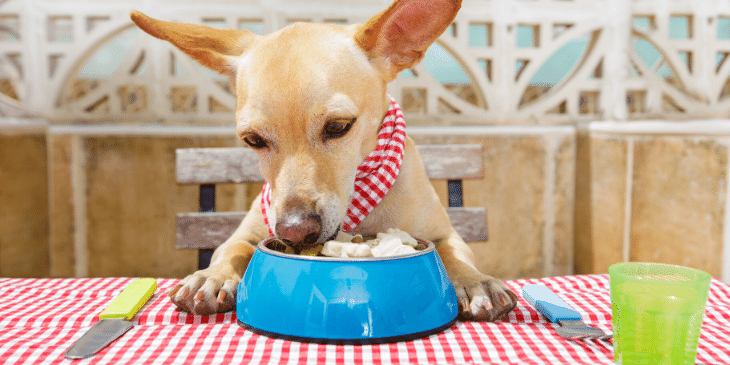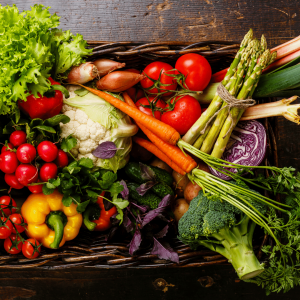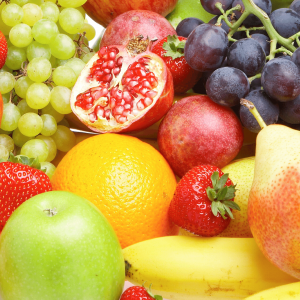Fruits & Vegetables Dogs Can Eat For Health

Contents
We’ve all been told by our veterinarians that too many treats can make our pups fat and be harmful to their health. Offering them fruits and vegetables seems like a healthy compromise. After all, if it’s good for you, it must be good for them, right? Actually, not always. Many human foods can be dangerous or unhealthy for our fur babies. Pet owners must learn which fruits and vegetables dogs can eat, and which ones they can’t.
Your dog’s digestive system is quite a bit different than yours, and eating certain foods can lead to stomach upset, health issues, and even death in some cases. Dogs are omnivores, which means they can digest meat and plants, but some plants contain substances that are toxic to dogs. On the other hand, they do contain fiber, phytonutrients, vitamins, and minerals, so offering the right ones can be beneficial to your dog’s health
Here’s a look at which common fruits and vegetable dogs can eat for better health, as well as which ones should be avoided.

Vegetables Dogs Can Eat, and Which Ones They Can’t
Many animal nutritionists believe that dogs need some vegetables in their diet to be healthy. Although their diet should be mostly meat, vegetables can provide some fantastic nutrients to the diet and add fiber, which is great for the digestive system. If your dog needs to lose a little weight, consider reducing the amount of kibble at each meal and replacing it with an equal amount of baby carrots, frozen green beans, or other dog-safe vegetables. It’s an easy way to fill him up but still cut back on the calories.
· Leafy Green Vegetables
In general, your dog can eat any leafy green vegetables that you would normally eat. This includes kale, cabbage, swiss chard, and all types of lettuce. Leafy greens are loaded with nutrients like potassium, iron, calcium, and vitamins A, C, and K. They’re also rich in fiber, which is excellent for digestive health. The nutrients are depleted a bit with cooking, but you can steam, bake, or dehydrate leafy greens before adding them to your pup’s food if you like. Be sure to introduce them slowly, in small amounts, because all of that fiber could lead to an upset stomach if you give too much when your pup isn’t used to it.
· Spinach
Spinach is one leafy green that should only be offered to dogs in small amounts. It contains a substance called oxalic acid, which can prevent the body from absorbing calcium and could lead to kidney damage. Your dog would have to consume a lot of spinach to have any issues, but it’s still worth noting.
· Squash and Pumpkin
Pumpkin and squash are safe for dogs to eat, and many dogs enjoy them. Pumpkin is wonderful for the digestive system and can be helpful for pups who are suffering from constipation and diarrhea. You can add steamed, cubed or pureed squash and pumpkin to your dog’s food for a nutrition and fiber boost. Just be sure you’re offering only pure squash or pumpkin with no spices or salt added, and don’t give your dog the skin or seeds, only the flesh.
· Beans and Peas
Legumes such as peas and beans are often included in pet foods, but their use is controversial. The FDA recommends against overfeeding legumes and potatoes. While it’s ok to offer them as a treat in moderation, they should not be relied on as your dog’s main source of protein because that could lead to a heart condition. If your dog’s food already contains legumes, avoid giving him additional legumes as a treat, and consider changing his food to one that uses meat, fish, or poultry as the protein source instead.
· Green Beans
It’s important to note that the rules about legumes don’t apply to green beans. Most dogs love the taste of green beans and find them very easy to digest. Offer them fresh, steamed, or frozen whenever you like. They make a fantastic filling and low calorie treat for dogs.
· Root Vegetables
Root vegetables are generally safe to give dogs. Many dogs love carrots and sweet potatoes, but they can also eat beets, parsnips, and regular potatoes in moderation, too. Root vegetables are very nutritious, but they’re also higher in sugar, so don’t overfeed them. If your dog’s food already includes root vegetables, it’s best to avoid offering them as a treat.
· Stalks
Stalks like asparagus and celery are safe for dogs, but most dogs don’t care for them. They tend to be fibrous or stringy, which makes them difficult for pups to chew. If you really want to offer them to your dog, steaming them and chopping them up into small pieces may help.
· Alliums
Shallots, leeks, chives, onions, and garlic are all alliums and they are toxic to dogs. Raw onions, garlic, and other alliums can lead to anything from a mild tummy ache to anemia and eventual organ shut down. Use extreme diligence to ensure that your dog never gets access to alliums!
· Other Veggies Your Dog Can Eat in Small Amounts
Cucumbers, sweet peppers, corn, cauliflower, broccoli, and brussels sprouts are all safe for dogs in small amounts. Cruciferous vegetables (like broccoli and brussels sprouts) can lead to an underactive thyroid in some dogs, so it’s a good idea to consult with your vet before offering them. Corn cobs are not safe for dogs at all, so be sure to take the corn off the cob before feeding. Introduce these veggies in small amounts to avoid an upset tummy, especially if your dog isn’t used to eating fresh veggies.

Fruits Dogs Can Eat and Which Ones They Shouldn’t
Fruits are rich in antioxidants and other nutrients, so it’s great to incorporate them into your dog’s diet in moderation as well. Keep in mind that fruits contain more sugar than vegetables, so approach them with caution if your dog is overweight or has diabetes. Here’s a list of common fruits that can be fed to dogs, plus a few that should be avoided.
· Apples and Pears
Apples and pears are safe for dogs, as long as you remove the core and seeds first. They’re a great source vitamins A and C, as well as fiber.
· Bananas
Bananas are high in sugar, but they’re good for dogs in small amounts. They contain potassium and other nutrients that are beneficial for your dog’s health.
· Blueberries
Blueberries are safe for dogs, and they contain beneficial antioxidants that prevent cell damage and may reduce the risk of cancer.
· Cantaloupe
Cantaloupe is another antioxidant-rich fruit that’s fine for dogs in moderation. It’s also a great source of fiber, which is good for digestion.
· Mangoes
Mangoes are safe for dogs, as long as the skin and pit are removed. They’re full of potassium, beta-carotene, and vitamins A, B6, C, and E, which are all great for your dog’s health.
· Oranges
Oranges are fine for dogs in small amounts but remove the peel and seeds first. They’re rich in vitamin C, fiber, and potassium.
· Peaches
Peaches are fine for dogs in small quantities and they’re a great source of vitamin A, which fights infections. Never give your dog peach pits because they contain small amounts of cyanide.
· Pineapple
Pineapple is great for dogs because it contains bromelain, which is an enzyme that’s good for digestion. Be sure to peel it first and remove the tough inner core.
· Watermelon
Watermelon is great for hydration and it’s full of vitamins A, B6, C, and potassium. It’s great for dogs, but you must remove the seeds and rind first.
· Fruits That Should Not Be Given to Dogs at All
Tomatoes, avocadoes, grapes, and raisins should never be fed to dogs. They all contain toxic substances that can make your dog very sick and may even be fatal.
Final Things to Keep in Mind When Feeding Fruits & Vegetables to Your Dog
The most important thing to remember is to pay attention to your dog whenever you change his diet. Introduce new things slowly and stop offering them if he shows any signs of stomach upset. If you have any reason for concern, call the vet right away.
That being said, adding a little variety to your dog’s diet by offering nutritious fruits and vegetables can be great for his health. If your dog loves treat puzzle games, you can use his favorite healthy fruits and vegetables in place of fattening treats. It’s also a great way to switch things up and keep him interested.
For dogs who don’t enjoy the taste of fruits and veggies, you can try pureeing them and adding them to his regular food for a boost of nutrition. You can also dehydrate them, grind them into a powder in your food processer, and then sprinkle them over top of his food.
It’s always a good idea to consult with your vet before making any drastic changes in your dog’s diet, especially if he has a health condition or takes medication. Fruits and vegetables can provide a nutritious boost to your dog’s diet and help him live a longer, healthier life– as long as the guidelines in this article are followed.
